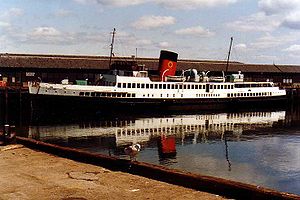TS Queen Mary
- For other ships called Queen Mary, see Queen Mary (ship).
Coordinates: 51°30′33.21″N 0°07′6.90″W / 51.509225°N 0.118583°W

The two funnel Clyde steamer TS Queen Mary was built at the William Denny shipyard at Dumbarton for Williamson-Buchanan. The 871 gross tons steamer was powered by three direct drive steam turbines, and carried 2086 passengers making her the largest (though not the longest) excursion turbine on the River Clyde.
In service
In 1933 she joined the Williamson-Buchanan fleet, taking over from the first Clyde turbine steamer, the 1901 TS King Edward on the run from Glasgow down the River and Firth of Clyde to Rothesay, Millport and Arran. In 1935 the fleet including Queen Mary passed to the London, Midland and Scottish Railway Company, and her registered owners became Williamson-Buchanan (1936) Ltd. Also in 1935, Williamson-Buchanan were contacted by the Cunard Company which was getting ready to have its new liner launched by Her Majesty Queen Mary – so Cunard reached agreement with Williamson-Buchanan that the turbine steamer would become TS Queen Mary II, and presented a portrait of Her Majesty to hang in the forward lounge of the Clyde steamer, while their liner became the RMS Queen Mary.
TS Queen Mary II was a roomy and comfortable ship, well suited to the large numbers of passengers on the route, with passenger capacity making up for a modest speed of 19.7 knots on trial. She was a two class ship, with cabin passengers housed forward and the top deck extending aft giving steerage passengers a share of it as well as sheltered space below. Though the rest of the fleet was painted in the LMS livery with yellow funnels, she retained her white funnels and Williamson-Buchanan house-flag until the war.
Wartime and post-war
During World War II, she worked on maintaining Clyde services while many other steamers became minesweepers or anti-aircraft vessels. After the war, she returned to service in LMS livery with yellow funnels; then, post war 1948 nationalisation of the railways brought the steamers under the Caledonian Steam Packet Company (CSP) with the same livery. As traffic increased in the 1950s, modifications were made. Over the winter of 1956-1957 the TS Queen Mary II was changed from coal to oil burning, the two funnels were replaced by a single well proportioned funnel and a new mainmast was added so that she now had two masts to meet changed regulations for ship's lights, with her tonnage increasing to 1014.
In the 1960s, a gradual change in holiday habits and a succession of summers with poor weather led to a decline in Clyde sailings. While other ships were retired, the Queen Mary II was refitted and put on cruises from Gourock to Inveraray, Brodick and Campbeltown. The CSP had been gradually merging with the west highland ferry company MacBraynes, and in 1973 the company became Caledonian MacBrayne Ltd. After a disappointing first season, they decided to reduce their fleet, with the paddle steamer PS Waverley being handed to a preservation society, and its routes taken over by the Queen Mary (which lost the "II" as the Cunard liner had now been retired).
Retirement
Waverley survived and prospered, but with the shift to diesel car ferries and cost pressures the TS Queen Mary was retired after a last evening showboat cruise from Largs to Rothesay on 27 September 1977. She was then laid up in the East India Harbour, Greenock. At some time in the 1980s the ship was bought by Bass Leisure Retail and taken south to London to become a floating pub/restaurant. She underwent a £2.5m refurbishment in 1997 and was moored at Victoria Embankment. Facilities included two bars and two function rooms. The top deck of the ship was used as an open air venue with bar facilities.
In November 2009, the ship was towed out of London.[1] She is to be renovated and moored in La Rochelle, France, as a floating restaurant and fitness centre.[2]
Footnotes
- ↑ "Tower Bridge site: Bridge Lift Times". http://www.towerbridge.org.uk/TBE/EN/BridgeLiftTimes/. Retrieved 2009-11-09. Text included: DAY Mon DATE 09 Nov TIME 14:15 VESSEL TS Queen Mary & Tug DIRECTION Down (meaning down-river)
- ↑ "BBC London News: Victoria Embankment has taken a step back into its past with the towing away of the Queen Mary pub boat.". BBC News. 2009-11-08. http://news.bbc.co.uk/local/london/hi/people_and_places/history/newsid_8346000/8346835.stm. Retrieved 2009-11-09.
References
- Clyde Pleasure Steamers - Ian McCrorie, Orr, Pollock & Co. Ltd., Greenock, ISBN 1-869850-00-9
- Queen Mary II information and photographs
- Welcome to T.S. Queen Mary Website
